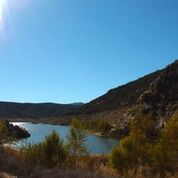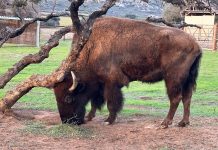The trailhead can be easily missed if you blink once while driving down on Japatul Road toward the Carveacre Wind Caves and Gaskill Peak, which are the two most popular hiking trails in Alpine. Loveland is a true hidden gem in the backcountry about a 40-minute drive from downtown San Diego off I-8 East.
The trailhead can be easily missed if you blink once while driving down on Japatul Road toward the Carveacre Wind Caves and Gaskill Peak, which are the two most popular hiking trails in Alpine. Loveland is a true hidden gem in the backcountry about a 40-minute drive from downtown San Diego off I-8 East.
The good news about not being a popular spot is that it is almost deserted, thus you can experience raw wilderness at its finest. The bad news about not being a popular spot is that … it is almost deserted, which means poor cell phone connection, light traffic on the main road and nobody to hear you screaming for help if you need to scream for help.
Although the hike is not very strenuous and you can see the lake from the road (OK, it’s 2 miles down), it’s better to be prepared with proper gear. Bringing enough water is a must, especially during the very hot summer we are experiencing lately. Keep in mind that hiking in 100-degree temperatures is not recommended. Go very early in the morning or wait for better days. The area is equally beautiful in the fall when the air starts cooling The lake is mainly a water reservoir owned by the Sweetwater Authority who partnered with the USDA Forest Services 19 years ago to provide public access to the lake. The rangers maintain the area and only the first part of the trail is marked. There is no fee for fishing, but a California state fishing license is required.
Due to the infestation of Quagga mussels, live bait is not allowed, neither is swimming or boating. Animals are not permitted, not even service dogs. If you’re not discouraged by so many restrictions and still believe that hiking to the dam or trying your luck on the 5-mile shoreline to fish at Loveland is a good idea, here’s a list of the fish you could catch: large mouth bass, bullhead catfish, red-eared sunfish, crappie and bluegill.
The entrance gate leads to a spacious but rocky parking lot that opens at sunrise and closes at 6 p.m., with the specification that any car left behind will be towed. No port-a-potty available at the trailhead, but there are some at the lake. Because of the extensive spread of the Quagga mussels, the location of the few port-a-potties provided around the lake is rather strange. They are all installed way up the hill and there’s no direct trail to any of them. You just have to make it through the stingy nettles and shrubbery.
The main trail debuts in an encouraging way though, looking well maintained and well marked with added rails for support. The road takes you down the hill rather fast so hiking poles would be a good idea to protect your knees. The landscape is inviting enough that you may want to take a break just half a mile down the path to admire the thick forest and the blooming chamise, but mainly to enjoy the only shaded spot for miles around.
Now you are ready to descend the 92 stairs to the bottom of the canyon. Although the hike is rated easy and considered mainly a path for fishing, there are hikers who believe the stairs make this trail an intermediate hike for people with locomotion problems and a no-go for hikers in wheelchairs. Keep the stairs in mind then, both ways.
Once at the bottom, say good-bye to natural shade and hello to your hat, sunscreen and lots of water. From now on there is only chaparral, sumacs, sage, buckwheat and thick grass to shade your feet.
To top it off, this is the end of the well-marked trail and machetes are not allowed. You kind of feel your way around by spotting the lake straight ahead and taking the path of least resistance — that’s the one without the stinging nettles, if you can find it. Long pants and good waterproof hiking boots are highly recommended, along with good balance for the rocky terrain.
During the drought, crossing the lake on the east side is treacherous through thick cattails and marsh.
The same vegetation is found on the west trail, making hiking on the muddy shoreline rather difficult. This may be the main reason why Loveland Lake is not perceived as a hiking spot per se, but more of a fishing destination.
After all, you want to experience backcountry and here it is in its entire splendor, with kingfishers on the rocks and redwing blackbirds chirping in the cattails, pelicans and herons winging it on the lake, all offering you an experience to make your courageous trip worthwhile.
I even spotted the precious least Bell’s vireo, an endangered species, and I have a picture to prove it.
There are multiple other options for hiking, but mainly on the trails up the hills and toward the dam. Speaking of the dam, it’s a relatively new construction from 1945 and helps store over 25,300 acre-feet of water serving 175,000 residents in Bonita, Chula Vista and National City.
I hiked this trail twice, once a couple of weeks ago very early in the morning and before that in November and I prefer the winter time.













